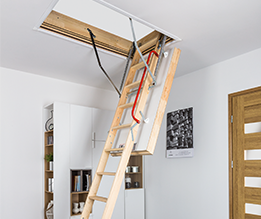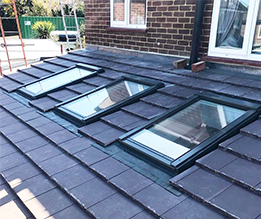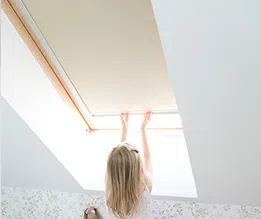How to measure for a replacement attic ladder
Replacing attic ladders may seem straightforward, but it’s a task that demands precision to ensure that your new ladder fits perfectly. A poorly fitting ladder can cause safety issues and might even lead to costly repairs. In this guide, we’ll walk you through the steps to measure for a replacement attic ladder, so you get the right fit first time.

Why are accurate measurements critical when replacing attic ladders?
Taking accurate measurements when replacing attic ladders is crucial for several reasons. Firstly, it ensures that it’s the right size for the attic door opening. A ladder that’s too small can create gaps, making the ladder unstable and posing the risk of accidents or damage. On the other hand, a ladder that’s too large might not fit through the opening.
Proper measurements are also important to avoid any issues with the ladder’s operation, such as difficulty in folding or extending. This is particularly important if you’re installing attic pull-down stairs. Making sure that your attic ladder measurements are accurate will also prevent unnecessary returns or exchanges, saving you time and money.


What steps are involved in measuring for replacement attic ladders?
Measuring for a replacement attic ladder involves several steps. You’ll need to measure the rough opening, ceiling height, floor-to-floor height, and swing clearance. It’s also essential to consider the attic access size, especially if you’re installing an attic ladder for a small opening. Follow the steps below for a detailed guide on each measurement.
What tools do you need?
Before you start measuring for your replacement attic ladder, you need to gather the following tools:
- Tape measure
- Step ladder to reach the attic access hole (if necessary)
- Pencil and paper for noting measurements
How do you measure the rough opening?
The first step is to measure the width and lengths of the rough opening. This is the space in the ceiling where the ladder or attic pull down stairs will be installed. Make sure to measure from the inside edges of the opening, as this is where the ladder frame will sit. If you’re replacing the ladder, the rough opening should match the dimensions of the new ladder’s frame. If you’re dealing with a small attic space, pay special attention to the attic access size to ensure a proper fit.
What’s the correct way to measure ceiling height?
To get an accurate measurement of your ceiling height, measure the distance from the floor of the room where the attic ladder will be installed to the ceiling. Use a step ladder if needed to reach the ceiling comfortably. This measurement is vital for determining whether a standard or extra-long attic ladder is required. Remember to measure from the finished floor and not from any carpeting or padding to get an accurate height.
How do you determine floor-to-floor height?
The floor-to-floor height is the distance between the floor of the room below and the floor of the attic. This measurement is particularly important for ensuring that your new attic pull-down stairs will extend fully and securely when in use. Start by measuring from the base of the floor below to the top of the attic floor, taking care to keep the tape measure straight for an accurate result. For pull-down attic stairs with a handrail, this measurement will also determine the appropriate length of the ladder.
Why is swing clearance important and how do you measure it?
Swing clearance refers to the amount of space required for the ladder to unfold and swing into its operational position. This measurement ensures that the ladder will open safely without hitting any obstacles, such as furniture, walls, or doorways. To measure the swing clearance, first note the distance from the attic door opening to any potential obstructions. You should also consider the angle at which the ladder will descend when extended. Accurate swing clearance is essential, especially when installing folding stairs for lofts with limited space.
What other measurements do you need to consider?
In addition to the primary measurements, you should consider the attic access size, which includes the depth and width of the attic entrance. This is particularly important if you’re installing an attic ladder for a small opening. Measuring the attic access size ensures that your new ladder can be manoeuvred easily into position during installation. For pull-down attic stairs with a handrail, check the handrail clearance as well to ensure it fits comfortably within the space.
Common mistakes to avoid when measuring for a replacement attic ladder
Even minor measurement errors can lead to a poor fit, so avoid these common mistakes:
- Rounding measurements: Always record precise measurements, down to the nearest millimetre.
- Measuring only once: Double-check your measurements to prevent discrepancies.
- Ignoring obstructions: Ensure that there’s no furniture, light fixtures, or beams obstructing the ladder’s operation.
- Not considering floor thickness: When measuring floor-to-floor height, include the thickness of the attic floor to avoid a ladder that’s too short.
Fakro products for different needs
Fakro offers a range of attic ladders to suit various spaces and requirements, from compact folding stairs for lofts to pull-down attic stairs with handrails for added safety. Whether you need an attic ladder for a small opening or a solution that accommodates a higher ceiling, Fakro’s selection ensures there’s a product for every need. Their ladders are designed with ease of use and durability in mind, making them a reliable choice for replacement attic ladders.
By taking the time to measure accurately and consider all factors, you’ll ensure a smooth installation process and a safe, long-lasting ladder.



